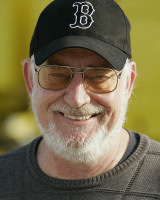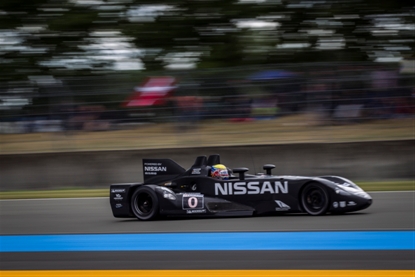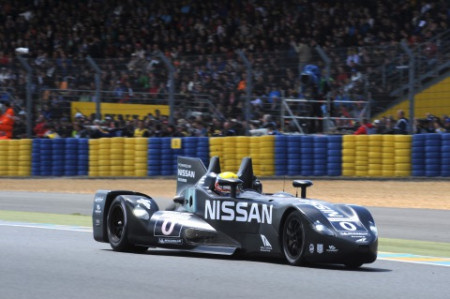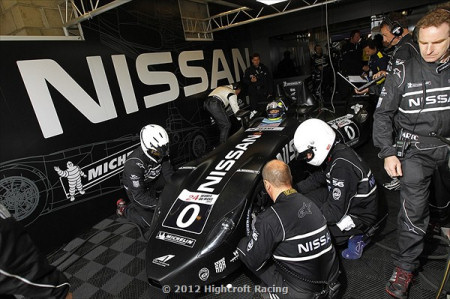The Way It Is/ Franchitti and Panoz discuss the Nissan-Delta Wingby Gordon Kirby |
 The Nissan-Delta Wing's much-anticipated debut at Le Mans unfortunately was cut short by an accident early in the race in which driver Satoshi Motoyama was an innocent victim. But the car performed well in all departments proving designer Ben Bowlby's theories entirely correct and without doubt worth pursuing. Last week I talked with some of the key men in the Delta Wing project including Don Panoz, designer Bowlby and lead test and race driver Marino Franchitti.
The Nissan-Delta Wing's much-anticipated debut at Le Mans unfortunately was cut short by an accident early in the race in which driver Satoshi Motoyama was an innocent victim. But the car performed well in all departments proving designer Ben Bowlby's theories entirely correct and without doubt worth pursuing. Last week I talked with some of the key men in the Delta Wing project including Don Panoz, designer Bowlby and lead test and race driver Marino Franchitti.
"For me personally, it was a tough race at Le Mans, not being able to actually drive in the race," Franchitti remarked. "But I'm very proud of being the main development driver and doing the heavy lifting and then the car performing like it did. It's very good for all of us involved in the Nissan-Delta Wing program. "I have to say I'm proud of the job Michael (Krumm) did at the beginning of the race and Satoshi as well. Satoshi did a great job of driving and then put a huge effort into trying to get the car back to the pits. Many people have said to me, and it's so true, that it was the spirit of Le Mans. He showed so much heart--the heart of a lion--in trying to get the car back. Both my teammates were fantastic people and fantastic drivers. It was a pleasure to share the car with them." Franchitti emphasized the huge effort required to get the Nissan-Delta Wing ready to race following a very tight build and test program. "The period of time we had to run it from a concept to a reality was so short and it gives me a lot of pride to have been part of that crew," Marino said. "Everyone worked at maximum capacity to make it happen. To make the decision to have the balance between reliability and performance and turning it into a race car and having it perform like it did, everyone did their job to the maximum."  © Nissan Delta-Wing "It was something very special for me to be the main driver involved in the development from the beginning," he observed. "It's something that I think I certainly won't see again in my career. I doubt that I'll have that opportunity to have the chance to take something from zero in every way with a completely new concept. "I've had an experience that no one else has and that's something very special for someone who loves the sport and the history of the sport. It allowed me to get a small look at what my heroes did back in the fifties and sixties." Franchitti was delighted with the Delta Wing's responsiveness when he first drove the car in February at Buttonwillow Raceway in California. "From the first test I knew the car would perform. There was a point in the first test where Ben said. 'Go out, feel it out and see how you feel.' There was a really fast right-hander and he said if everything's right with low fuel and new tires that should be flat, and within three laps I was flat through there. Ben was saying, 'It's just a shake-down, take it easy.' And I said, 'Ben, the car feels good.' "You know very quickly whether a car is good or not and I knew straight away this was a very good car. The thing that hit me straight away was how well the car changed direction. And number one on my list is the aero performance of the car--the fact that it has no wings and the underfloor really works well." Marino is pleased with how well the car runs in traffic. "You can't help to be affected when you're in the wake of another car, but I would say this car was affected less than other cars I've driven."  © LAT USA "We're still in the early stages of the evolution of this car. So far it's been about getting the car running as reliably and comfortably as possible. One point is we didn't have a diff on the car at Le Mans. We knew that this will give us a good step in performance but the reliability of the part at the moment and the lack of enough miles on it dictated that we couldn't run the diff. There's a lot of performance there both in braking and acceleration." Despite not being able to make a maximum attack qualifying run at Le Mans after the fire extinguisher went off Michael Krumm qualified the car in 3 minutes 42.6 seconds, only four seconds off the LMP2 pole. Franchitti believes the car could have achieved a quick lap some nine seconds faster which would have been almost five seconds under the LMP2 pole lap time. "We've only scratched the surface of the performance," Marino says. "If we had been able to go for it in qualifying, even without the diff, we still could have been in the mid to low 33s. That shows the performance that's untapped in the car. "I believe the car has a lot still to give so I think it would be criminal if this is the end of the story. It's not just that it has a lot of evolution to come. It's also that fans want to see it. People want to see it. I've never been as busy in my life since this program started between the testing program and all the stuff off the track that goes into developing a completely new car like this. "The week at Le Mans was the busiest week in my life," Marino added. "It went by like it was half a day. It was unbelievable how fast the time went. At Le Mans in the driver parade you get to feel like a rock star for an hour. But the Delta Wing extended that to the whole week. You couldn't go anywhere that people wanted you to sign something or talk about the Delta Wing. It was lovely. It was nice to see. It's not just good for the Delta Wing program but it's good for the whole sports car fraternity." The Delta Wing has also attracted a lot of interest from many people outside motor racing's usual sphere of influence. "It's got that X factor that brings in fans from outside the sport and that for me is more important than anything," Franchitti observed. "It puts eyes on the sport that aren't normally on it. For example, shortly after the car was first launched I went on my first visit to a new dentist who had no idea what I do and he said, 'Oh, you drive that Delta Wing car.' I said, 'Oh, you're a motorsports fan?' And he said, 'No, I just saw it on the news.' That's the kind of reach the car has and that's really quite cool."  © Nissan Delta-Wing "It was a very intense situation but they were good people to be working with." He underlined how well the Delta Wing's many disparate elements came together. "All the parts of the puzzle--Michelin, the Delta Wing partnership--Don Panoz, Chip Ganassi and Duncan Dayton--and Ben, Zach and Simon and all the engineers, plus all the guys on the engine side with RML and Nissan, and of course, Dan Gurney. There are so many different parts and for everyone to come out of it and be patting each other on the back, that's pretty special. When you have so many successful motorsport people involved in one program and they all came together and made this thing work, that's very rare." Franchitti said the Richard Mallock-developed 1.6 liter turbo four-cylinder Nissan engine ran like clockwork. "The engine is a revelation," he commented. "It's a great little piece. Nissan gave RML the MO on what they wanted and they have a lot of the technology in it that they are looking at for their future road cars, and it ran fantastically well. It gave us drivers everything we needed." As is well-known, the Delta Wing was designed to race, initially at least, with some 300 bhp to achieve the same lap speed as conventional cars with half the weight, half the drag, half the power and half the fuel and tire consumption. "Of course, you always want more power," Franchitti remarked. "But the numbers were very specific on what the car required and that's where we ran it. The engine is capable of producing more power. It took not only the efficient design that Ben and his guys came up with but it also took the Nissan engine to produce the kind of fuel figure that we required to get the job done with the efficiency we wanted. It's not just one part of the equation that does that." Unfortunately the car didn't get the chance to complete its first race thanks to an accident before sunset on Saturday with one of the Toyota LMP1 hybrids driven by former Williams F1 driver Kazuki Nakajima. "He just made an error," Franchitti commented. "He didn't allow enough clearance once he'd passed it to make a big move to the right. He knew it was there. If he hadn't seen the car he would have driven in the back of it before he even got alongside. He just made an error, unfortunately for us." Added Don Panoz: "The Toyota team all came up and apologized. Credit to them for doing that. That stupid mistake not only took us out but it kept them from having a chance to win. They paid a penalty too. Marino started driving for me a few years back and he's a mature guy who really tries and I felt really disappointed that he didn't get in for his stint." Marino says the Delta Wing affords an excellent view for the driver. "It has a better field of vision than any LMP car I've driven for a while because there are no wheel arches getting in the way. There's nothing but positives in that way. The mirrors on the car at Le Mans were so massive. They made us put on these P2 side mirrors and they were just too big for a car this size. But that's their Le Mans regulations." Franchitti has complete faith in the Delta Wing's crash safety believing its side-impact safety is a step forward on most modern race cars. "The car has been crash-tested as an LMP1-spec chassis. So safety is certainly not a worry. In fact, it's another step ahead because it's got the side impact panels that Don's Elan Group have developed. I think it has more side impact protection and intrusion protection than the regular cars. It certainly wasn't anything I was worried about. "The safety was never a worry for me with this car. After a couple of tests Ben said to me you know you're basically a test pilot because we think we know what's going to happen but we're not that sure and we send you out there and ask you to stand on it. But I've never babied this car throughout the whole development process. We've used it hard because when you get to racing you're going to use it hard. But I never questioned safety or anything else." Don Panoz reports that the Elan side panels improved intrusion protection by five times. "That's the FIA numbers from their tests," Panoz said. "Intrusion was improved by 500 percent versus anything else they tested. That's really good and they don't add any weight to the car." Panoz could not be more pleased with the way the Nissan-Delta Wing performed at Le Mans. "This car was able to perform and accomplish all the things that you would think a hybrid would do without the electric motor and batteries," Panoz remarked. "It uses less fuel and performs excellently at the top level and that to me was what's really very impressive because the technology is in the aerodynamics and the air is free. I made a point in an email that the massive amount of publicity and support that came out for this car overshadowed the Audi and Toyota hybrids." Panoz is working hard to make sure the Delta Wing races again this year at least at the Petit Le Mans at Road Atlanta in the fall. "Ben Bowlby had a great concept, a great idea, and now all your birthdays have come at once," Panoz grinned. "We have to thank Ben and the Gurneys and Chip Ganassi who really was the patron of the Delta Wing. He was the guy who first believed in Ben's concept and the support of Chip and the Gurneys and all the partners has been rewarded in the performance of the car. And to Nissan and their support and marketing activities for helping make the Delta Wing name known around the world to the media and fans. Many different people have made many contributions and we're grateful for all of them." For details of Panoz's hopes and plans for the Delta Wing's future read my blog 'Don Panoz on the Delta Wings future' posted today at Motor Sport's website, www.motorsportmagazine.com. And I'll have much more on the Delta Wing with designer Ben Bowlby in this space next week. |
Auto Racing ~ Gordon Kirby Copyright 2012 ~ All Rights Reserved |
